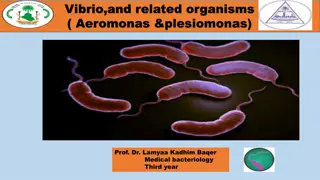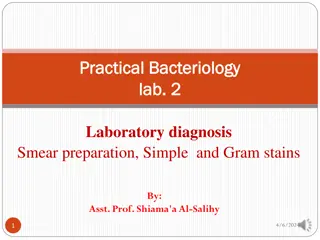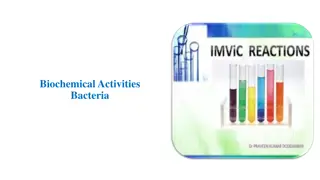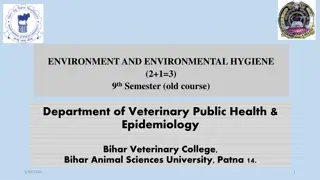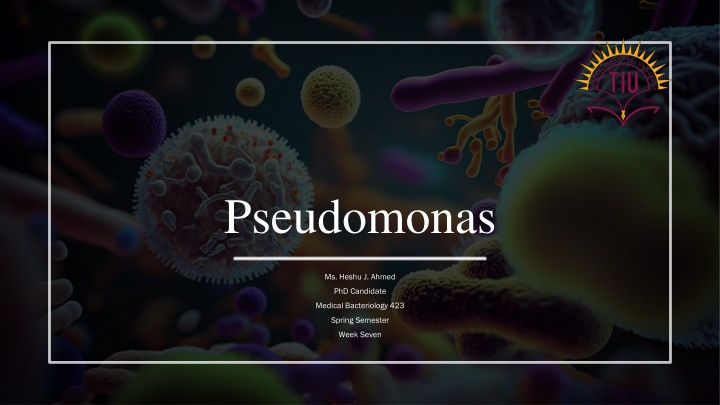
Pseudomonas aeruginosa: Epidemiology, Pathogenesis, and Manifestations
Explore the genus Pseudomonas focusing on the clinically significant species Pseudomonas aeruginosa. Understand the epidemiology, pathogenesis, and diverse manifestations of P. aeruginosa infections across various clinical contexts and body systems.
Download Presentation

Please find below an Image/Link to download the presentation.
The content on the website is provided AS IS for your information and personal use only. It may not be sold, licensed, or shared on other websites without obtaining consent from the author. If you encounter any issues during the download, it is possible that the publisher has removed the file from their server.
You are allowed to download the files provided on this website for personal or commercial use, subject to the condition that they are used lawfully. All files are the property of their respective owners.
The content on the website is provided AS IS for your information and personal use only. It may not be sold, licensed, or shared on other websites without obtaining consent from the author.
E N D
Presentation Transcript
Pseudomonas Ms. Heshu J. Ahmed PhD Candidate Medical Bacteriology 423 Spring Semester Week Seven
Outline Genus Pseudomonas Pseudomonas aeruginosa Epidemiology Pathogenesis Manifestations
Objectives 1. Provide an overview of the genus Pseudomonas and its most clinically significant species, Pseudomonas aeruginosa. 2. Explore the epidemiological factors contributing to the spread and prevalence of P. aeruginosa infections. 3. Examine the pathogenesis mechanisms employed by P. aeruginosa in causing opportunistic infections. 4. Discuss the diverse manifestations of P. aeruginosa infections across various body systems and clinical contexts.
Pseudomonas aeruginosa Pseudomonas aeruginosa is an aerobic, motile, gram-negative rod P aeruginosa is sufficiently versatile in its growth and energy requirements to use simple molecules such as ammonia and carbon dioxide as sole nitrogen and carbon sources. produces blue, yellow, or rust-colored pigments P.aeruginosa differentiates it from most other gram-negative bacteria The blue pigment, pyocyanin, is produced only by P aeruginosa. Fluorescein, a yellow pigment that fluoresces under ultraviolet light is produced by P aeruginosa and other species of pseudomonas.
Pseudomonas aeruginosa Lipopolysaccharide (LPS) and porin proteins are present in the outer membrane. Porin proteins in Pseudomonas offer less permeability compared to Enterobacteriaceae, restricting passage of various molecules including antibiotics. A mucoid exopolysaccharide slime layer is present outside the cell wall This layer is created by secretion of alginate Most strains of P aeruginosa produce multiple extracellular products, including: exotoxin A (ExoA) and other enzymes with phospholipase, collagenase, adenylate cyclase, or elastase activity.
Pathogenesis Although P aeruginosa is an opportunistic pathogen, it is one of particular virulence. The organism usually requires a significant break in first-line defenses: (such as a wound) or a route past them (such as a contaminated solution or endotracheal tube) Attachment to epithelial cells is the first step in infection and is likely mediated by pili, flagella, and the extracellular polysaccharide slime. The effect of ExoA is not immediate, since it is one of a number of virulence factors activated through a gene- regulating system called quorum sensing.
Quorum sensing Under these conditions, lactones and/or quinolones secreted by P aeruginosa signal their presence to the other bacterial cells. The system is quantitative so when the Pseudomonas cell population reaches a certain threshold, the signals direct the cytotoxin gene to be transcribed, and the toxin is then produced by the entire population at once.
References Sherris Medical Microbiology: An Introduction to Infectious Diseases. Jawetz, Melnick & Adelberg's Medical Microbiology by Geo. F. Brooks, Karen C. Carroll, and Janet S. Butel Prescott's Microbiology by Joanne Willey, Linda Sherwood, and Christopher J. Woolverton


